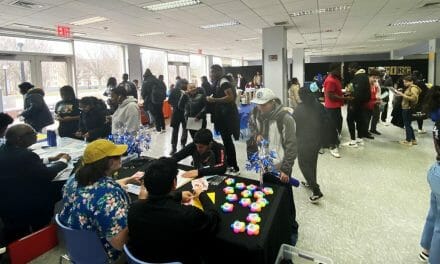Deaf and hard-of-hearing students within The City University of New York who don’t know American Sign Language (ASL) are gaining access to lectures, thanks to the CUNY Captioning Initiative, which began at the College of Staten Island.
According to Maryellen Smolka, a co-facilitator of the Initiative, CUNY is seeing more and more deaf and hard-of-hearing students who don’t know ASL because there is a trend in the medical community to promote cochlear implants, in an effort to encourage these people to integrate more fully into society. As a result, new ways of imparting lecture materials to them had to be created.
Smolka says that such a student enrolled at CSI in 2002. The College faced the costly option of using court reporters (then charging, on average, $135 per hour) to turn lectures into text. Realizing that this was a cost-prohibitive route, Smolka explored other options, and with financial backing from CSI Vice President for Technology Systems Michael Kress and support from the CSI Division of Student Affairs’ Office of Disability Services, she found a solution.
Initially, CSI employed a masked microphone, like those used for translation purposes in the United Nations, which prevents others in the room from hearing what is said. A CART (Communications Access Real-Time Translation) Provider listens to a lecture and speaks into the microphone, which, through voice-recognition software, produces text on the student’s laptop computer, while he or she is in the classroom.
The College eventually expanded the Initiative by training CART Providers from other CUNY campuses and offering the services of their own providers to other University schools, providing crucial lecture materials to students, and literally saving the University hundreds of thousands of dollars by avoiding costly court reporter fees. “These savings also allow all other students to have more and better resources throughout the University,” Smolka notes.
In addition, Smolka reports that there are now other ways to get lecture materials into students’ hands. In cases where students cannot attend a lecture, text that is transcribed by CART providers is emailed to students and, just recently, CART providers can connect to a lecture via the Internet, transcribe the material, and send it to a student anywhere in the world in real time.
Smolka explains the importance of the Initiative, “If a deaf or hard-of-hearing student misses one class or one word…that can adversely affect an entire semester. I know that that sounds dramatic, but it’s happened already, so it’s not as dramatic as it might sound…” She also stresses that the Initiative helps to level the playing field for all students, giving everyone equal access to class material.
Nicole Dory, the Initiative’s Information Support Assistant, is responsible for the technical end of things. Although she has to cope with the occasional Internet glitch, or even the rare weak microphone battery, she is proud to be a part of the Initiative. “It’s exciting to see how the students benefit from it because it makes them more independent.” She also notes that all of the participating students’ grade point averages have increased, thanks to the fact that they now have access to accurate lecture transcriptions.
All of this wouldn’t have happened, according to Smolka and Dory, without the help of Vice President Kress. “Our mentor and supporter is Dr. Kress,” Smolka says. “No matter what we ask for, he just jumps in and gives it to us. The trick is that we never ask for anything that we don’t need.”
In the future, Smolka and Dory hope to expand the number of students who can utilize the Initiative’s services by establishing a center on the CSI campus that will house CART Providers for CSI and other CUNY schools.
















